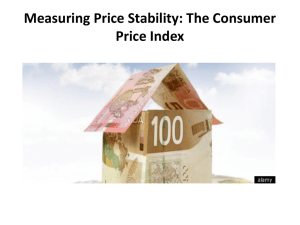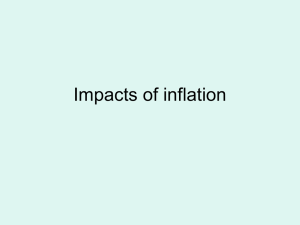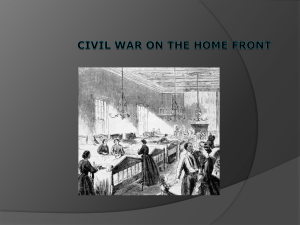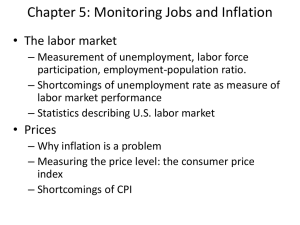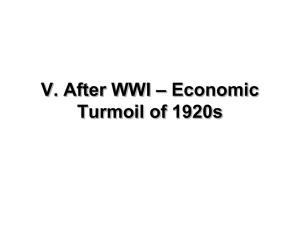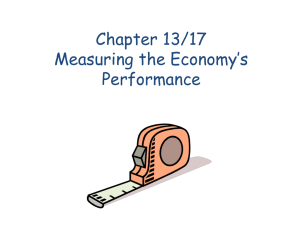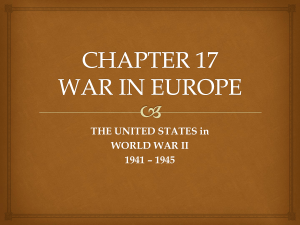Slides - High School Economics - Council for Economic Education
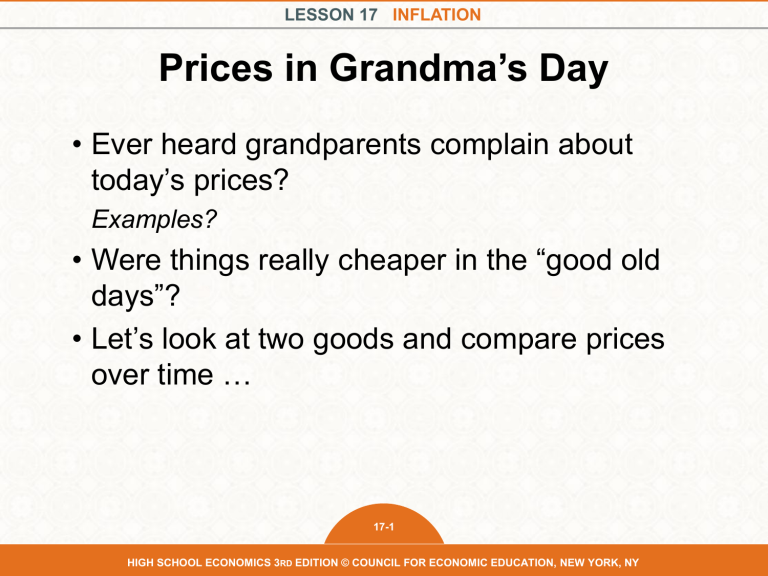
LESSON 17 INFLATION
Prices in Grandma’s Day
• Ever heard grandparents complain about today’s prices?
Examples?
• Were things really cheaper in the “good old days”?
• Let’s look at two goods and compare prices over time …
17-1
HIGH SCHOOL ECONOMICS 3 RD
EDITION © COUNCIL FOR ECONOMIC EDUCATION, NEW YORK, NY
LESSON 17 INFLATION
Movie Tickets and Big Macs
®
What was average price of a movie ticket in 2012?
What was average price of a movie ticket in 1967
(35 years ago)?
What was average price of a McDonald’s Big Mac ® in
2012?
What was average price of a McDonald’s Big Mac ® in
1967?
17-2
HIGH SCHOOL ECONOMICS 3 RD
EDITION © COUNCIL FOR ECONOMIC EDUCATION, NEW YORK, NY
LESSON 17 INFLATION
How Much Have Prices Changed?
• Measure percent change in prices from one year to another.
• Percent change formula:
Price in Year 2 (2012) – Price in Year 1 (1967) /
Price in Year 1 (1967) x 100
17-3
HIGH SCHOOL ECONOMICS 3 RD
EDITION © COUNCIL FOR ECONOMIC EDUCATION, NEW YORK, NY
LESSON 17 INFLATION
How Much Have Prices Changed?
Table 17.1-A Historic Prices
Goods
Price in
1967
Price in
2012
Percent
Change in Price
1967 Price in
2012 Dollars
$7.92
Movie Ticket $1.22
McDonald’s
Big Mac
®
$0.45
$4.33
17-4
HIGH SCHOOL ECONOMICS 3 RD
EDITION © COUNCIL FOR ECONOMIC EDUCATION, NEW YORK, NY
LESSON 17 INFLATION
How Much Have Prices Changed?
Table 17.1-B Changes in Overall Price Level
Goods
Price in
1967
Price in
2012
Percent
Change in Price
1967 Price in
2012 Dollars
$7.92
549% Movie Ticket $1.22
McDonald’s
Big Mac
®
$0.45
$4.33
862%
17-5
HIGH SCHOOL ECONOMICS 3 RD
EDITION © COUNCIL FOR ECONOMIC EDUCATION, NEW YORK, NY
LESSON 17 INFLATION
Purchasing Power
• Prices are the amount of currency (in dollars) needed to purchase particular goods and services.
• “Purchasing power” refers to the amount of goods or services that can be purchased with an amount of dollars.
• Could you survive today if you made the same salary as your grandfather did in 1967?
• The purchasing power of dollars is eroded by overall price increases.
– Because prices tend to rise (due to inflation), you'd need a much larger salary to maintain the same standard of living.
• You would need an increase in salary of 549 percent and 862 percent (for Big Macs ® and movie tickets) to be as well off as your grandfather was in 1967.
• How many Big Macs ® could be bought for $1 in 1967? In 2012?
17-6
HIGH SCHOOL ECONOMICS 3 RD
EDITION © COUNCIL FOR ECONOMIC EDUCATION, NEW YORK, NY
LESSON 17 INFLATION
Inflation
• Inflation is a rise in the general (or average) level of prices of goods and services in an economy over a period of time.
– A trend, not a one-time event
– A rise in most, if not all, prices over time
• When the general (or average) price level rises, purchasing power decreases and our currency buys fewer goods and services.
• Price level is typically measured in the United States by the U.S. Bureau of Labor Statistics (BLS) and compiled as the U.S. Consumer Price Index (CPI).
17-7
HIGH SCHOOL ECONOMICS 3 RD
EDITION © COUNCIL FOR ECONOMIC EDUCATION, NEW YORK, NY
LESSON 17 INFLATION
Consumer Price Index
• The index that is used to measure average changes in prices paid by consumers in urban markets for a market basket of commonly purchased goods and services.
• Compares the combined price of all of these goods and services in the market basket from one month to the next.
• The BLS collects information about the prices of goods and services in eight major categories.
17-8
HIGH SCHOOL ECONOMICS 3 RD
EDITION © COUNCIL FOR ECONOMIC EDUCATION, NEW YORK, NY
LESSON 17 INFLATION
Consumer Price Index
• FOOD AND BEVERAGES
(breakfast cereal, milk, coffee, chicken, full service meals, snacks)
• HOUSING
(rent of primary residence, owners' equivalent rent, fuel oil, bedroom furniture)
• APPAREL
(men's shirts and sweaters, women's dresses, jewelry)
• TRANSPORTATION
(new vehicles, airline fares, gasoline, motor vehicle insurance)
• MEDICAL CARE
(prescription drugs and medical supplies, physicians' services, eyeglasses and eye care, hospital services)
• RECREATION
(televisions, toys, pets and pet products, sports equipment, admissions)
• EDUCATION AND COMMUNICATION
(college tuition, postage, telephone services, computer software and accessories)
• OTHER GOODS AND SERVICES
(tobacco and smoking products, haircuts and other personal services, funeral expenses)
17-9
HIGH SCHOOL ECONOMICS 3 RD
EDITION © COUNCIL FOR ECONOMIC EDUCATION, NEW YORK, NY
LESSON 17 INFLATION
Working with CPI
• Index: a mathematical tool that substitutes an index level for the overall price of a market basket.
• All indices use a base year—for easy reference—set to an index level of 100, and the CPI uses 1982−84 as its reference base.
• The average price of all of the goods and services in the market basket for the years 1982, 1983, and 1984 is set to 100.
• This base level is used to calculate changes in prices of the market basket.
• An index of 105 (for 1985) means there has been a
5 percent increase in the price of the market basket since base year.
17-10
HIGH SCHOOL ECONOMICS 3 RD
EDITION © COUNCIL FOR ECONOMIC EDUCATION, NEW YORK, NY
LESSON 17 INFLATION
Working with CPI
• Changes in the index can be expressed as percent changes, either monthly or annually, called the inflation rate .
• The inflation rate: the percent change in the CPI over the reference period. Here is a formula for calculating inflation rate (Note: Year 1 is the earliest year):
CPI (Year 2) – CPI (Year 1) x 100
CPI (Year 1)
• For example, the inflation rate from 1990 to 1991 was
4.2% :
CPI (1991) – CPI (1990) x 100 = (136.2 – 130.7) x 100 =
CPI (1990 130.7
= (5.5/130.7) x 100 = 0.420 x 100 = 4.2%
17-11
HIGH SCHOOL ECONOMICS 3 RD
EDITION © COUNCIL FOR ECONOMIC EDUCATION, NEW YORK, NY
LESSON 17 INFLATION
Working with CPI
Table 17.2-A Calculating Inflation Rates
CPI
(Year 1)
CPI
(Year 2)
Calculations
1995
Inflation
Rate
2005
2012
17-12
HIGH SCHOOL ECONOMICS 3 RD
EDITION © COUNCIL FOR ECONOMIC EDUCATION, NEW YORK, NY
LESSON 17 INFLATION
Working with CPI
Table 17.2-A Calculating Inflation Rates
CPI
(Year 1)
CPI
(Year 2)
1995 148.2
Calculations
152.4
[(152.4 – 148.2)/148.2] x 100
Inflation
Rate
2.8%
2005 188.9
2012 224.9
195.3
[(195.3 – 188.9)/188.9] x 100 3.4%
229.6
[(229.6 – 224.9)/224.9] x 100 2.2%
17-13
HIGH SCHOOL ECONOMICS 3 RD
EDITION © COUNCIL FOR ECONOMIC EDUCATION, NEW YORK, NY
LESSON 17 INFLATION
How Much Have Prices Changed?
Table 17.2-B Changes in Overall Price Level
Goods
Price in
1967
Price in
2012
Percent
Change in Price
Converting Grandpa’s
Prices: 1967 Price x
(2012 CPI / 1967 CPI)
$7.92
549% Movie Ticket $1.22
McDonald’s
Big Mac
®
$0.45
$4.33
862%
17-14
HIGH SCHOOL ECONOMICS 3 RD
EDITION © COUNCIL FOR ECONOMIC EDUCATION, NEW YORK, NY
LESSON 17 INFLATION
How Much Have Prices Changed?
Table 17.2-B Changes in Overall Price Level
Goods
Price in
1967
Price in
2012
Percent
Change in Price
Converting Grandpa’s
Prices: 1967 Price x
(2012 CPI / 1967 CPI)
$7.92
549% $8.39
Movie Ticket $1.22
McDonald’s
Big Mac
®
$0.45
$4.33
862% $3.09
17-15
HIGH SCHOOL ECONOMICS 3 RD
EDITION © COUNCIL FOR ECONOMIC EDUCATION, NEW YORK, NY
LESSON 17 INFLATION
Using CPI Data
Table 1.
17-16
HIGH SCHOOL ECONOMICS 3 RD
EDITION © COUNCIL FOR ECONOMIC EDUCATION, NEW YORK, NY
LESSON 17 INFLATION
Unanticipated Inflation:
“Winners” and “Losers”
• Inflation: a long-term rise in average prices for all goods and services.
• When inflation is anticipated, consumers and producers can plan for its effects.
• When inflation is not anticipated , there are winners and losers.
• What happened to purchasing power …?
17-17
HIGH SCHOOL ECONOMICS 3 RD
EDITION © COUNCIL FOR ECONOMIC EDUCATION, NEW YORK, NY
LESSON 17 INFLATION
Determining Winners and Losers
Lenders
Goal: Loan funds at a rate of interest that is higher than inflation. If the interest rate charged is more than the actual inflation rate, the purchasing power of the money paid back to the lender is greater. If not, the purchasing power of the money paid back to the lender decreases.
Borrowers
Goal: Borrow funds at the lowest possible interest rate. If the inflation rate is higher than the interest rate on the loan, the purchasing power of the funds that the borrower pays back decreases, so a borrower may find it easier to pay back the loan (particularly if wages have increased with inflation).
Savers
Goal: Save funds at a rate of interest higher than inflation. If the interest rate earned is higher than the actual inflation rate, the purchasing power of savings increases. If not, the purchasing power of the savings decreases.
Workers
Goal: Earn wages that increase at a rate that is higher than the inflation rate. If wages increase faster than the rate of inflation, the purchasing power of the wages increases. If not, the purchasing power of the wages decreases.
17-18
HIGH SCHOOL ECONOMICS 3 RD
EDITION © COUNCIL FOR ECONOMIC EDUCATION, NEW YORK, NY
LESSON 17 INFLATION
Losers
Loser
1. Hourly-wage worker agrees on January 1, 2013, to a three-year union contract at a local factory. A fixed cost-of-living adjustment (COLA) of 2.5
percent per year is built into the contract.
Explanation
Wage increase is less than inflation; purchasing power of wages decreases.
3. Working mother of two children who purchased a six-month certificate of deposit (CD) on January 1,
2013, paying 3 percent annually.
4. Retiree living on Social Security benefits. No cost-of-living adjustment (COLA) is scheduled until
December 31, 2013.
5. Large local bank that holds many fixed-rate
30-year home mortgages at an interest rate of
5 percent.
Interest rate is less than inflation rates; purchasing power of savings decreases.
COLA comes at the end of the year; purchasing power throughout the year decreased.
Loans paid back at an interest rate of 5 percent are worth less to the bank over time; especially true of long-term loans.
7. Teenager whose college fund is in a savings account with an interest rate of 2 percent.
8. John, who loaned $1,000 to his friend Julie. Julie pays John back $1,050 after one year, as they agreed.
Interest rate is less than inflation rates; purchasing power of savings decreases.
By the time he is reimbursed, his money is worth less in terms of purchasing power.
17-19
HIGH SCHOOL ECONOMICS 3 RD
EDITION © COUNCIL FOR ECONOMIC EDUCATION, NEW YORK, NY
LESSON 17 INFLATION
Winners
Winner
2. Homeowner with a 30year fixed-rate (5 percent) mortgage.
6. Small business that signed a three-year fixedrate lease on office space.
Explanation
Because the fixed rate is lower than the rate of inflation, the real interest rate is negative. The money the homeowner pays on the loan has less purchasing power; the homeowner is giving up less (in terms of goods and services that she could purchase) than when the inflation rate was lower.
Although the nominal price remains the same for three years, because the inflation rate has eroded purchasing power, the “real” rent payment has less purchasing power than the landlord anticipated. The small-business owner benefits.
17-20
HIGH SCHOOL ECONOMICS 3 RD
EDITION © COUNCIL FOR ECONOMIC EDUCATION, NEW YORK, NY

